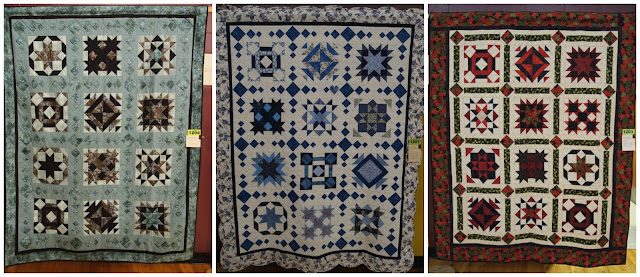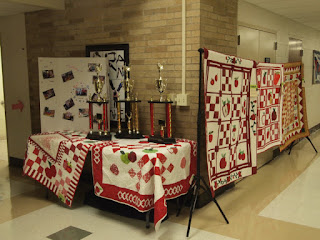I'll share the exciting news first: I have finished the hand quilting on the old quilt top from Kentucky that I have been working on! All the flowers are done and so are all of the setting triangles between them.
It's been about a six weeks since I last wrote about it, and since then, I have done nothing but quilt, quilt, quilt whenever I have been sitting on the couch. (And it's football season, so that is a lot of time!) I found working on the setting triangles was nice "straight line" work as I tried to watch the games.
I also had to replace the fabric in four of the flowers. (I thought I was done after three, but then found a flower I had missed!) Here is how I did it:
I put a piece of paper under the quilt where I wanted to replace the flower fabric.
I poked a pin through the fabric and paper at all of the seam intersections and then connected the dots, which yielded a pattern like so:
(Where I've written "pin" indicates the pin on the quilt so that I could make sure to keep the shape lined up.) I figured the quilt was so irregular that there was no way I was going to be able to use an "idealized" six-petaled flower and have it work in the block. The blocks are wonky; I may as well work with it.
After numbering the pieces, I cut them out and taped them to the fabric so I could mark a 1/4" seam on all sides:
Then I cut out the shapes:
I kept the paper on while I hand stitched the seams between the petals. It helped keep things lined up and gave me a reference for where to sew.
Removing the paper yields the flower:
After setting the seams and pressing them all in one direction (not for any good quilting reason; just because I couldn't make myself do it any other way):
And presto majesto, you have a replacement flower:
Yes, I could have cut out one piece of fabric in this shape, but I wanted to keep the block more authentic with the seams between the petals.
I then picked out the seams around the flower and took it out of the quilt. I was lucky with the first block that all of the seams were pressed away from the flower. So all of these muslin parallelograms are pressed under and ready to receive the new fabric.
I simply laid in the new shape (matching the "pin" marking I made at the start) and put the folded edges of the muslin parallelograms over it. I then basted it in place. I tried pins at first, but they allowed for too much shifting of the fabric.
Once basted, I hand stitched the muslin down using an applique stitch.
Once the outside edges were done, I removed the center hexagon from the old flower, pressed it well and basted and stitched it down over the center of the flower.
Once again, I got lucky as all the seams were pressed toward the centre. For some of the later blocks, I had to iron the edges of the centre piece over. It was a weird fabric--definitely not 100% cotton--and didn't iron well, but we managed. Again, basting with thread helps a lot.
And after quilting and removing the basting, you have a brand new block!!
Here are the other new fabrics I used to replace frayed flowers. A nice stripe:
I studied stripes already in the quilt to see how they handled them. (Where they parallel to a certain side? Did they all line up? Did they run around the block?) And it looked like they matched the stripe to one side seam in each piece, but didn't worry about how they lined up in the block. So that's what I did and I still ended up with a sort of pattern.
The stripe was an older fabric, but this floral was quite new:
I thought it would blend in well enough. In this case, I radiated the stems of the flowers on the print from the centre of the flower.
And for the fourth flower that I discovered later, I used this "Persian pickle" pattern. Well, it's not quite a paisley but I thought it was close enough!
In this case, I deliberately matched two sets of designs that alternate around the block. I cut these pieces from leftover strips from the library quilt I made. I didn't have the right pieces to make six matching blocks (sort of a kaleidoscope effect), but I think this is nice too.
So now that part is done. I'm going to quilt the outer blocks that I added later by machine. I think it's appropriate since they were added later, and there's no way I could hand quilt through the sheeting fabric (as in, sheets cut up to use as fabric). I had a thought to remove them entirely, but by then I had quilted to the edges and couldn't take them off anymore! (Or not without more work than I was willing to do.)
Now I'm debating adding a wide border to make this more of a queen size or whether to just add a binding and call it done. I'll have a while to think about it because I have some other projects to get to and need to put this aside. (Or I'm going to try. My obsessiveness has latched onto this pretty hard. We'll see if I can transfer it to another project!)
Meanwhile I'm pretty pleased with having it done, improvement in my hand quilting skills, all the fun fabrics in the quilt, the look of the quilted fabric, and the fact that this really didn't take very long once I started actually doing it.
Oh Scrap! : A Little Late
-
I have been having a heck of a time for the last few weeks remembering what
day of the week it is. I know I am not the only one - a reader emailed me
ye...
11 hours ago






























































